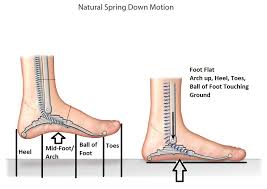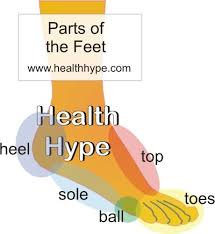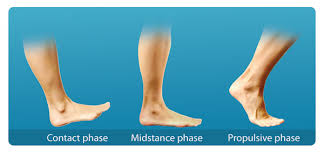So we have seen what contributes to walking wrong. But what, from a technical point of view, makes this happen? There are four (4) key elements to walking wrong and I'm going to take you through them now, starting with your feet and ankles moving on to your big leg muscles, then your head, neck and upper back and finally your arms and shoulders.
1. Your feet and ankles
Problem: the passive foot strike


A passive foot strike is one of the most common walk-wrong problems. Your foot and ankle have three 'rocker' (pivot points : the heel, the ball of the foot and the toes - see below.

These should work together to create a smooth 'rolling' movement: from the heel, to the ball of the foot, to the toes - see below


But for most of us, this important rolling or rocking movement has been lost, and the foot hits the ground more or less flat, all in one go. The impact of this travels all the way up your body, from your feet through your knees and hips. This puts stress on your joints and can compress the discs in your spine [ this is one reason why many people get knee, hip, and back pain as they age]. It also stops the muscles in your foot and your lower leg from moving as well as they should.


Over time, your foot becomes less and less mobile or pliable - and it no longer sends the same feedback to your brain. This lack of feedback, in turn, affect your balance, posture and the quality of your movements. You grow increasingly unsteady and begin to move with a more 'shuffling gait - your feet going straight down, rather than rolling and springing. Your foot's muscle tone becomes poor and weak, you are more likely to injure and strain yourself and you lose - quite literally - the 'spring in your step'. This feedback from foot to brain is called proprioception. It is a vital part of Walkactive.


1. Your feet and ankles
Problem: the passive foot strike
A passive foot strike is one of the most common walk-wrong problems. Your foot and ankle have three 'rocker' (pivot points : the heel, the ball of the foot and the toes - see below.
These should work together to create a smooth 'rolling' movement: from the heel, to the ball of the foot, to the toes - see below

But for most of us, this important rolling or rocking movement has been lost, and the foot hits the ground more or less flat, all in one go. The impact of this travels all the way up your body, from your feet through your knees and hips. This puts stress on your joints and can compress the discs in your spine [ this is one reason why many people get knee, hip, and back pain as they age]. It also stops the muscles in your foot and your lower leg from moving as well as they should.


Over time, your foot becomes less and less mobile or pliable - and it no longer sends the same feedback to your brain. This lack of feedback, in turn, affect your balance, posture and the quality of your movements. You grow increasingly unsteady and begin to move with a more 'shuffling gait - your feet going straight down, rather than rolling and springing. Your foot's muscle tone becomes poor and weak, you are more likely to injure and strain yourself and you lose - quite literally - the 'spring in your step'. This feedback from foot to brain is called proprioception. It is a vital part of Walkactive.

No comments:
Post a Comment